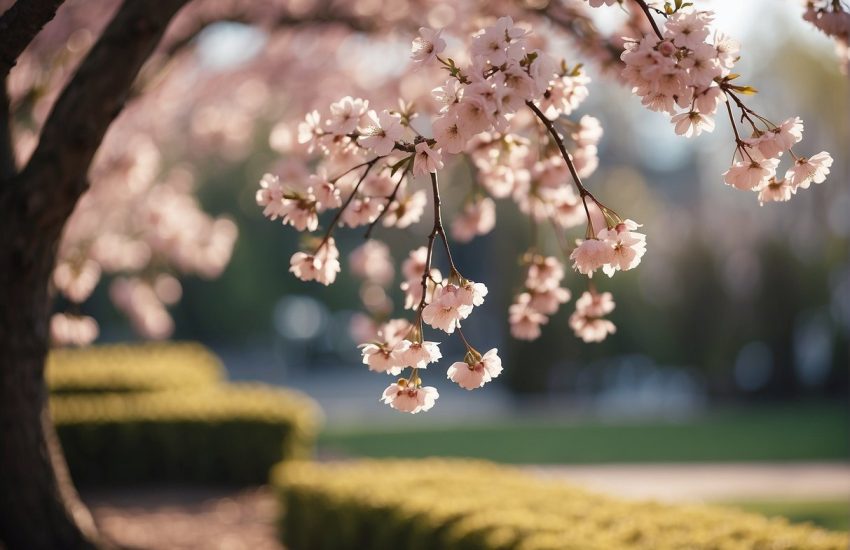Growing Lavender in Pots: Tips and Tricks for a Successful Harvest
Lavender is a beautiful and fragrant herb that can be grown in pots and containers, making it an ideal choice for those who don’t have a lot of space. Growing lavender in pots is a great way to add color and fragrance to your patio, balcony, or windowsill. In this article, we will explore the benefits of growing lavender in pots, and provide some tips for successfully growing this versatile herb.
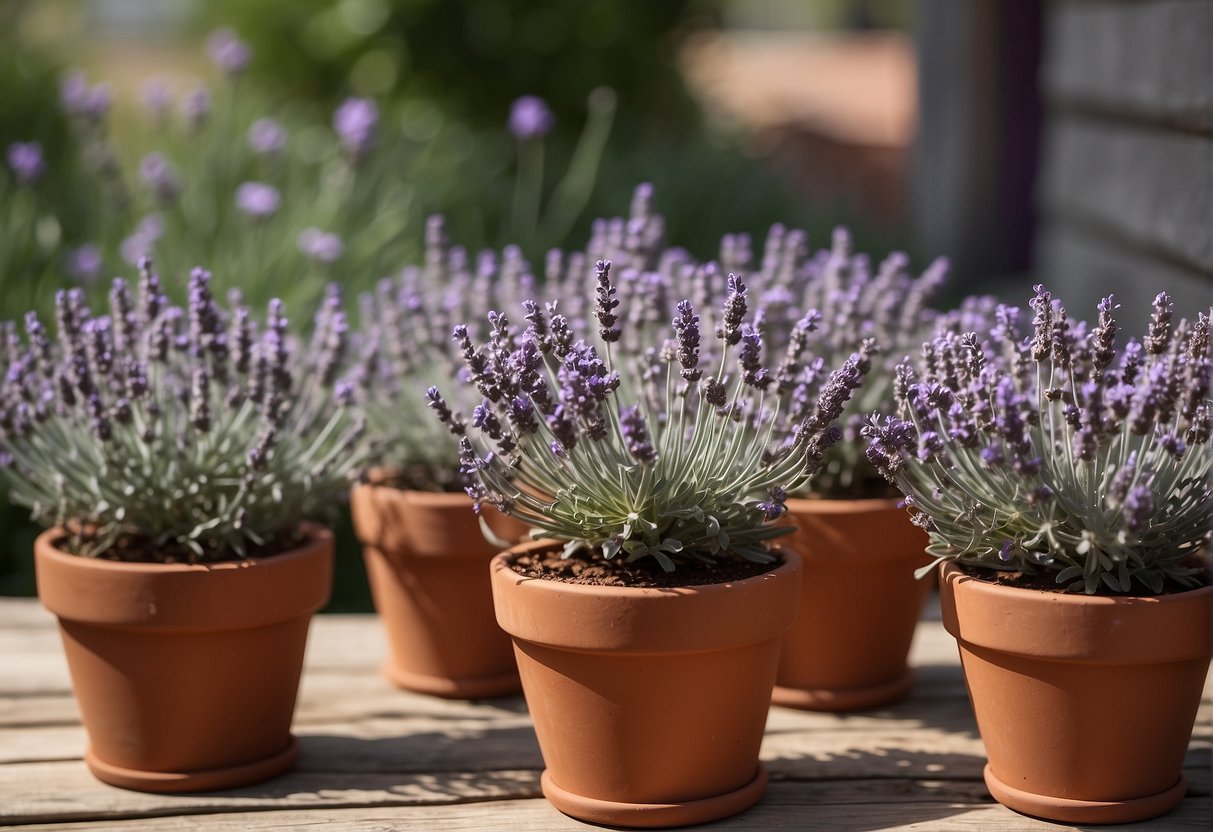
One of the main benefits of growing lavender in pots is that it allows you to control the soil conditions and drainage. Lavender prefers well-draining soil, and pots provide an ideal environment for ensuring that the soil is not too wet or compacted. Additionally, growing lavender in pots allows you to move the plant around to find the perfect amount of sunlight and shade. This is particularly important in areas with hot summers, where too much sun can damage the plant.
When it comes to choosing pots for growing lavender, there are a few things to keep in mind. The pot should be large enough to accommodate the plant’s roots, and should have drainage holes to prevent water from pooling at the bottom. Additionally, it’s important to choose a pot that is made from a material that will not absorb too much moisture, such as terra cotta or plastic. By following these simple tips, you can successfully grow lavender in pots and enjoy its beauty and fragrance all year round.
Choosing the Right Pot
When it comes to growing lavender in pots, selecting the right pot is crucial. The pot you choose should provide enough space for the plant to grow, good drainage, and proper aeration. Here are some important factors to consider when choosing the right pot.
Material Considerations
The material of the pot is an important consideration when growing lavender. Terracotta pots are popular because they are porous and allow for good aeration. However, they can also dry out quickly, which can be detrimental to lavender plants. Clay pots are also a good option because they are sturdy and can retain moisture. Wood pots are another option, but they may not last as long as other materials.
Size and Drainage
The size of the pot is also important. Lavender plants require well-draining soil, so it is essential to choose a pot with drainage holes. The pot should be deep enough to accommodate the root system of the plant and provide enough space for growth. A pot that is too small can lead to stunted growth, while a pot that is too large can lead to overwatering and root rot.
In summary, when choosing a pot for growing lavender, it is important to consider the material, size, and drainage. Terracotta and clay pots are good options for their porousness and moisture retention, respectively. The pot should have drainage holes and be deep enough to accommodate the plant’s root system. By selecting the right pot, you can ensure that your lavender thrives in a container garden.
Preparing the Soil Mix
Selecting Soil Components
When it comes to growing lavender in pots, selecting the right soil components is crucial for the plant’s growth and development. A well-draining soil mix is essential as lavender plants do not tolerate wet roots. The best soil for lavender in pots is a mix of potting soil, perlite, coarse sand, and vermiculite.
Potting soil provides the necessary nutrients for the plant, while perlite and coarse sand help with drainage and aeration. Vermiculite helps retain moisture, which is important for the plant’s growth.
Mixing for Optimal Drainage
To prepare the soil mix, start by mixing equal parts of potting soil, perlite, and coarse sand in a large container. Add one part vermiculite to the mix and blend well.
It’s important to note that the soil mix should be well-draining but not too dry. If the soil mix is too dry, it can cause the plant to wilt and die. On the other hand, if the soil mix is too wet, it can lead to root rot.
In summary, preparing the soil mix for growing lavender in pots requires a careful selection of soil components and a proper mix for optimal drainage. By following these steps, you can ensure that your lavender plant thrives in its new home.
Planting and Watering Lavender
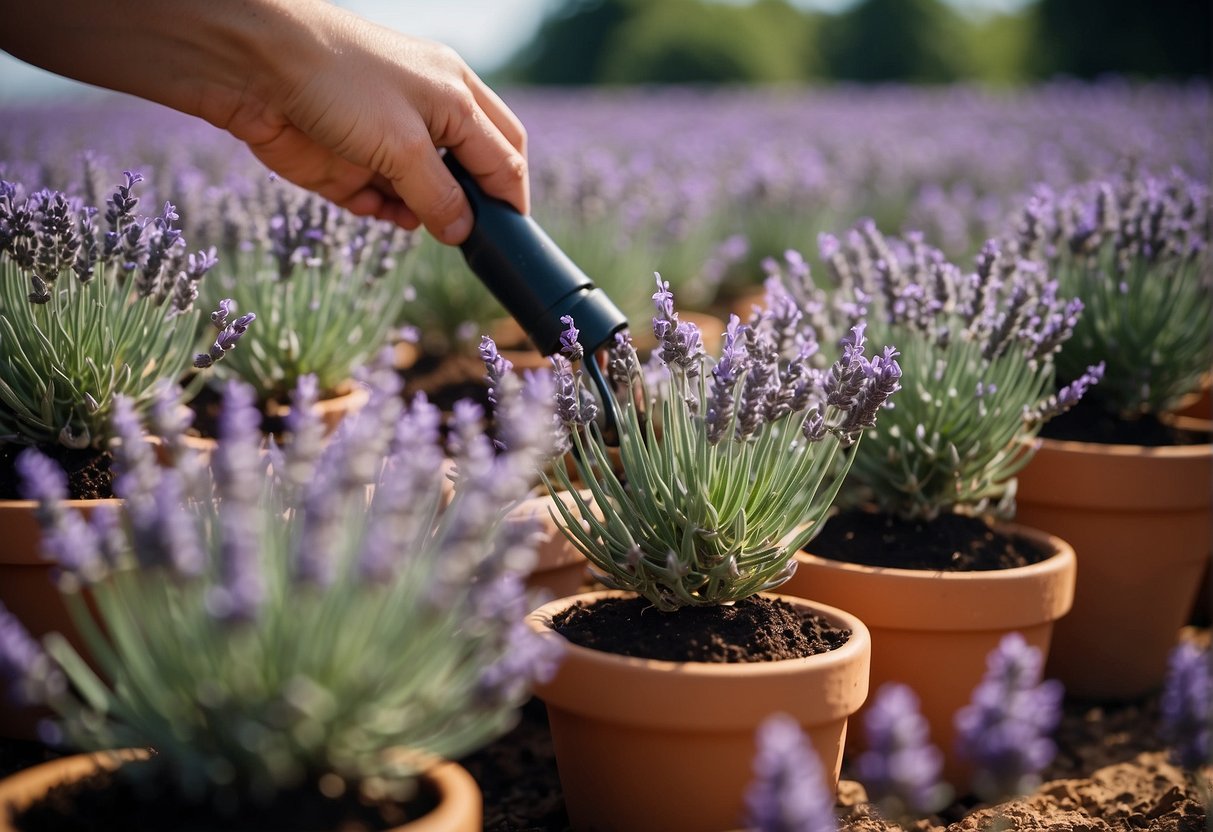
Transplanting Lavender
When transplanting lavender into a pot, it is important to choose a container that is at least 12 inches deep and wide, with good drainage holes. Fill the bottom of the pot with a layer of gravel or broken pottery to ensure proper drainage. Use a well-draining potting mix that is specifically formulated for herbs or succulents. Place the lavender plant in the center of the pot and fill the remaining space with soil, leaving about an inch of space at the top. Gently press the soil around the plant to remove any air pockets.
Watering Techniques
Lavender plants prefer well-draining soil and do not tolerate standing water. It is important to water lavender sparingly, allowing the soil to dry out slightly between watering. Overwatering can cause the roots to rot and lead to the death of the plant. The frequency of watering will depend on the size of the pot, the type of soil, and the climate. In general, lavender plants in pots require more frequent watering than those planted in the ground.
To determine if the plant needs water, stick your finger about an inch into the soil. If it feels dry, it is time to water. When watering, water the soil around the plant, avoiding getting water on the leaves. Water in the morning or early evening to avoid evaporation during the heat of the day. In hot and dry climates, lavender plants may require daily watering, while in cooler and more humid climates, watering once a week may be sufficient.
In summary, when planting lavender in a pot, choose a well-draining container and potting mix. Water sparingly, allowing the soil to dry out slightly between watering. Water the soil around the plant, avoiding getting water on the leaves, and water in the morning or early evening to avoid evaporation. With proper care, lavender plants can thrive in pots and provide a fragrant addition to any space.
Caring for Potted Lavender
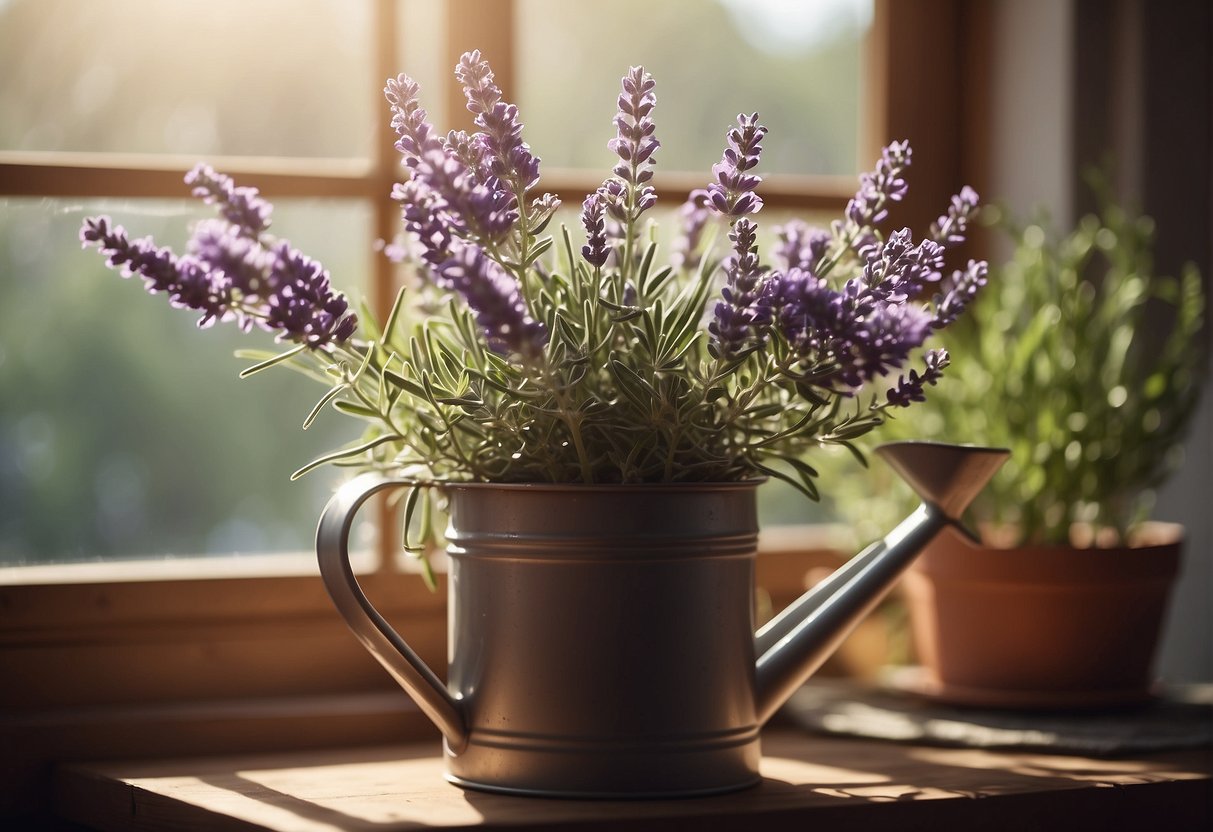
Sunlight and Location
Lavender plants require plenty of sunlight, so it’s best to place your potted lavender in a location that receives full sun for at least six hours a day. If you’re growing lavender indoors, place your pot near a south-facing window or under grow lights that provide full-spectrum light.
It’s important to note that lavender plants can be sensitive to heat, so make sure to avoid placing your pot in direct sunlight during the hottest part of the day. If you’re growing lavender outdoors, consider providing some shade during the hottest part of the day to prevent your plant from becoming stressed.
Pruning and Maintenance
Pruning is an essential part of caring for potted lavender. Regular pruning will help your plant maintain its shape and promote healthy growth. It’s best to prune your lavender in the spring, just as new growth begins to appear.
To prune your lavender, use a sharp pair of pruning shears to remove any dead or damaged stems. You can also remove up to one-third of the plant’s total growth to encourage new growth and promote a bushier plant.
In addition to pruning, it’s important to fertilize your potted lavender to help it thrive. Use a slow-release fertilizer formulated for herbs and apply it according to the manufacturer’s instructions. Be careful not to over-fertilize, as this can lead to weak growth and fewer blooms.
Overall, caring for potted lavender requires attention to sunlight and location, as well as regular pruning and fertilization. By following these simple steps, you can enjoy beautiful, fragrant lavender plants in your home or garden.
Overcoming Challenges
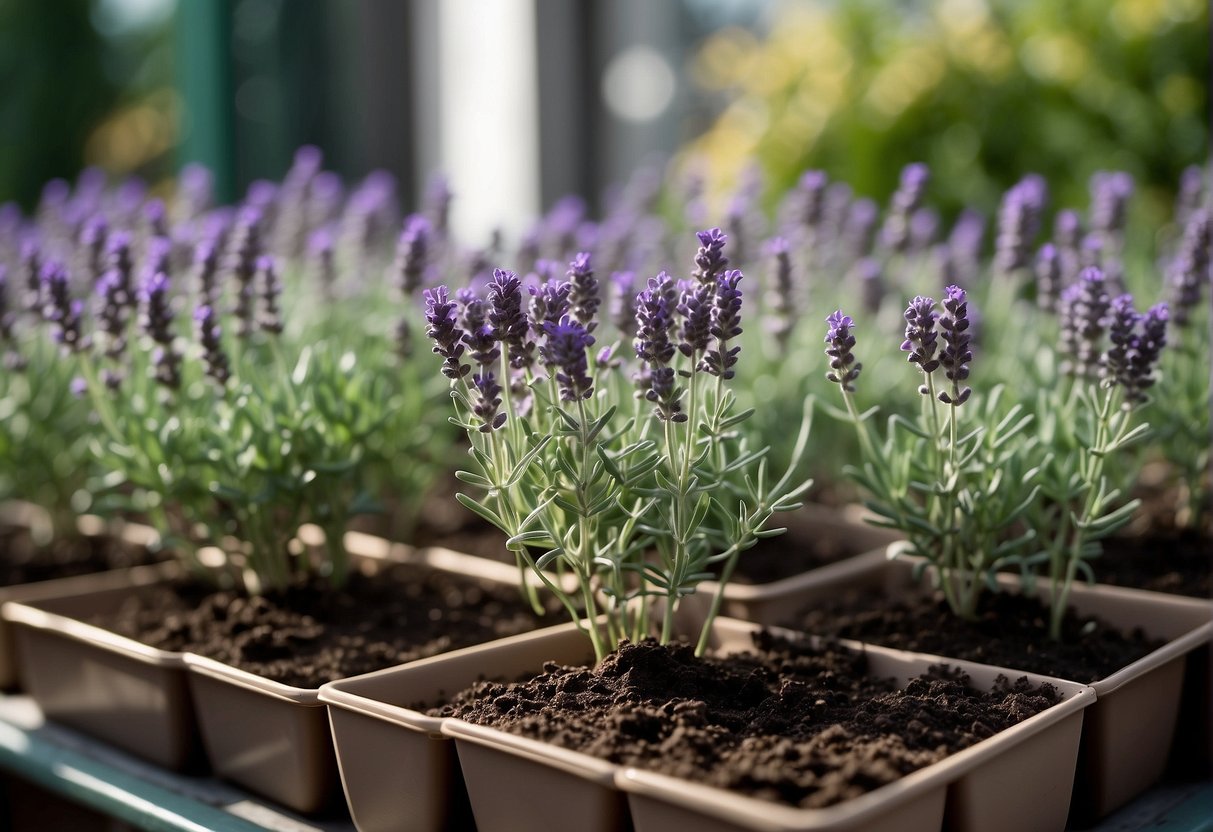
Dealing with Pests and Diseases
One of the biggest challenges of growing lavender in pots is dealing with pests and diseases. Lavender plants are susceptible to pests such as aphids, spider mites, and thrips, which can damage the leaves and flowers. They are also prone to diseases such as root rot, powdery mildew, and leaf spot.
To prevent pests and diseases, it is important to keep the plants healthy and well-maintained. This includes providing them with adequate sunlight, proper drainage, and regular watering. It is also recommended to use organic pest control methods such as neem oil, insecticidal soap, or diatomaceous earth.
Managing Overwintering
Overwintering is another challenge when growing lavender in pots. Lavender plants are hardy and drought-tolerant, but they are not cold-hardy and can be damaged by freezing temperatures. To overwinter lavender plants in pots, it is important to take the necessary precautions.
First, make sure the pots are placed in a sheltered location away from harsh winds and extreme temperatures. Second, provide the plants with a layer of mulch or straw around the base of the plant to protect the roots from freezing. Third, reduce watering during the winter months to prevent soggy soil, which can lead to root rot.
With proper care and attention, lavender plants can thrive in pots and add beauty and fragrance to any space. By following these tips and techniques, gardeners can overcome the challenges of growing lavender in pots and enjoy the benefits of these beautiful and aromatic plants.
Frequently Asked Questions
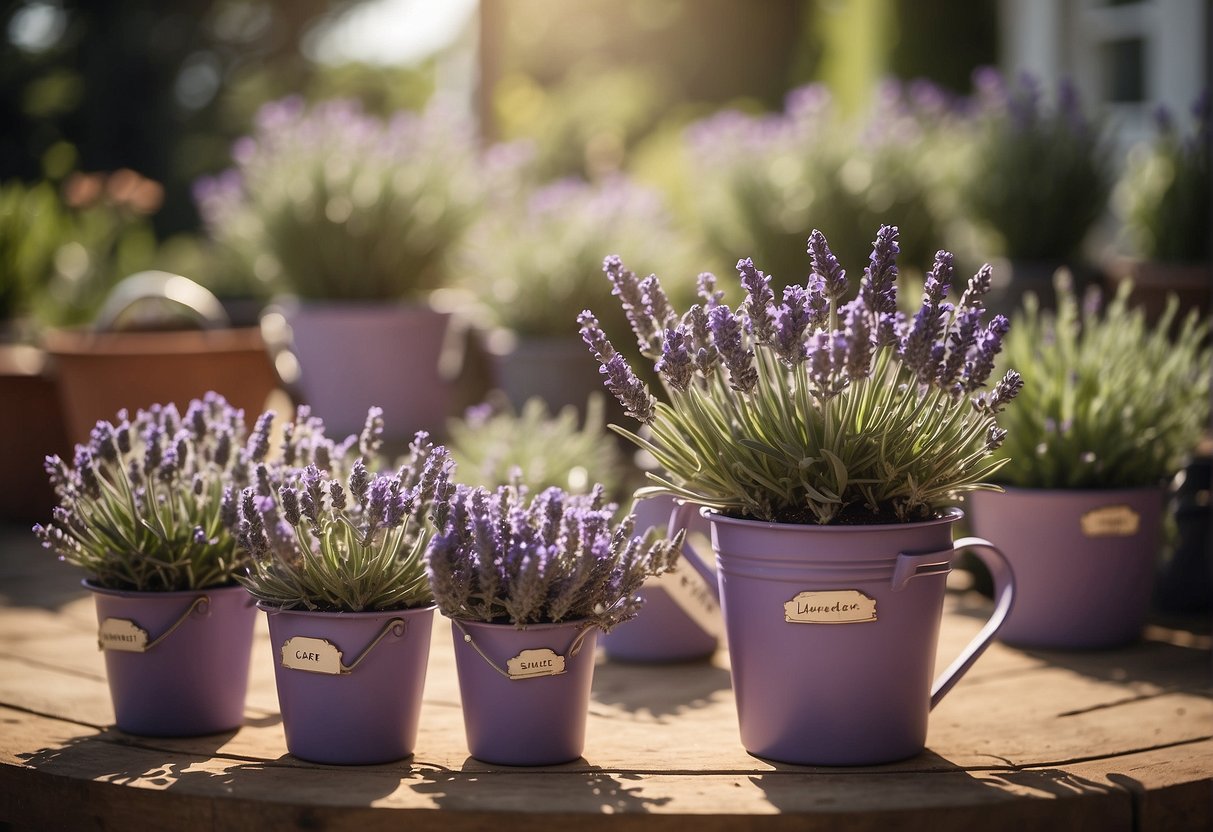
What is the best soil mix for lavender in containers?
The best soil mix for lavender in containers is a well-draining mix that is slightly alkaline with a pH between 7 and 8. A good mix can be made by combining equal parts of potting soil, coarse sand, and perlite.
How much sunlight is required for potted lavender to thrive?
Potted lavender requires at least 6 hours of direct sunlight per day to thrive. It is best to place the container in a sunny location, such as a south-facing window or a sunny balcony.
What are the common reasons for lavender dying in pots and how can I prevent it?
The common reasons for lavender dying in pots are overwatering, poor drainage, and lack of sunlight. To prevent this, ensure that the pot has good drainage holes, water only when the soil is dry to the touch, and place the pot in a location with adequate sunlight.
Can lavender be grown with other plants in the same pot, and if so, what are suitable companion plants?
Lavender can be grown with other plants in the same pot, but it is important to choose companion plants that have similar growing requirements. Suitable companion plants for lavender include rosemary, thyme, and sage.
What are the steps to successfully grow lavender from seed in containers?
To successfully grow lavender from seed in containers, start by filling a container with a well-draining soil mix. Sow the seeds on top of the soil and cover with a thin layer of soil. Keep the soil moist and place the container in a warm, sunny location. Once the seedlings have grown to a height of 2-3 inches, thin them out to one plant per container.
How can I keep my potted lavender healthy throughout the changing seasons?
To keep potted lavender healthy throughout the changing seasons, ensure that the soil is well-draining and that the pot has good drainage holes. Water only when the soil is dry to the touch and fertilize with a balanced fertilizer once a month during the growing season. In the winter, move the pot to a cool, dry location and water sparingly.

